Antonio Gallo's Blog: MEDIUM, page 63
January 21, 2023
A proposito di dialetti: un’educazione linguistica

Ho avuto sempre un rapporto conflittuale con il dialetto, sin dai tempi di quando discutevo con il mio collega e amico di sempre prof. Salvatore D’Angelo. Ho detto prima che i libri sono come le ciliege ed infatti viene fuori un altro libro, questo scritto e pubblicato da Salvatore alla fine dell’anno 1982. Tra le tematiche da lui trattate c’era anche la questione del dialetto.
Così scrivevo qualche tempo fa in un post qui al link a proposito di questo conflitto. Il caso ha voluto, chiamatela anche coincidenza significativa, che nel mettere ordine nella mia biblioteca, mi sia imbattuto in un testo che avevo del tutto dimenticato di avere tra i quelli dedicati allo studio delle lingue.
Una curatela pubblicata nel 1997 dall’editore Routledge, London and New York, diretta da Martin Heiden, professore di lingue romanze alla Università di Oxford, Fellow del Trinity College. Un’autorità del ramo affiancato da Mair Parr, professore associato di Italiano all’Università di Bristol.
Un libro davvero esclusivo per quei linguisti che ritengono non esserci nessuna altra parte d’Europa con questa grande varietà di strutture linguistiche, i cosiddetti dialetti, come in Italia.
Nello studio, i dialetti italiani vengono affrontati da diversi esperti, con interventi su temi riguardanti la fonologia, la morfologia, la sintassi, il lessico, le areee dialettali, e gli aspetti storici e sociolinguistici. Nel libro si sostiene che la nostra penisola è un ambiente unico in Europa nel campo della dialettologia.
Si parte della individuazione delle strutture linguistiche, si passa alla verifica delle aree coinvolte, a partire dal Nord del Paese, passando per il Centro, arrivando al Sud. Un capitolo conclusivo si sofferma sugli aspetti sociolinguistici e sulle relazioni esistenti tra la lingua standard e i vari dialetti.
Si evidenzia e si conferma nel libro il costante confronto/conflitto tra la lingua standard e la realtà storica, culturale e sociale dei luoghi dove la comunicazione assume forma di dialetto. Con tutte le relative frizioni e interferenze.
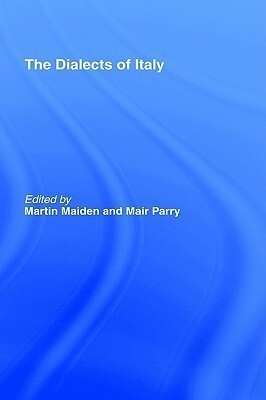 Il Libro
Il Libro
Una esperienza che, nonostante tutto quello ho appena detto, non sembra abbia minimamente condizionato il professore D’Angelo nella sua azione di insegnante di lingua francese. Fece, infatti, un’interessante esperienza didattica che lo vide protagonista un trentina di anni fa, gennaio-febbraio 1995, durante l’insegnamento nel Paese di Striano (Napoli).
Fu anche premiato dalla Regione Campania con gli alunni della “Scuola Media D’Avino” per essere riuscito ad insegnare la lingua francese, passando attraverso il dialetto, anzi, addirittura, utilizzandolo per veicolare la lingua straniera.
L’occasione gli venne fornita dalla celebrazione del 50 anniversario della Liberazione nel Comune dei piccolo paese di Striano, al confine tra la provincia di Salerno e di Napoli.
Con i suoi alunni si inventarono tre personaggi: Severino, un ragazzo, un “umano”, Pippinella e Ciccillo, appartenenti al “regno animale”, una cagna e un gatto. Gli studenti elaborarono la linea grafica narrativa con disegni a fumetti nei quali vennero inseriti opportuni dialoghi nelle tre lingue.
Si partiva del dialetto, passando per il francese, si arrivava all’italiano. Un percorso davvero ardito.

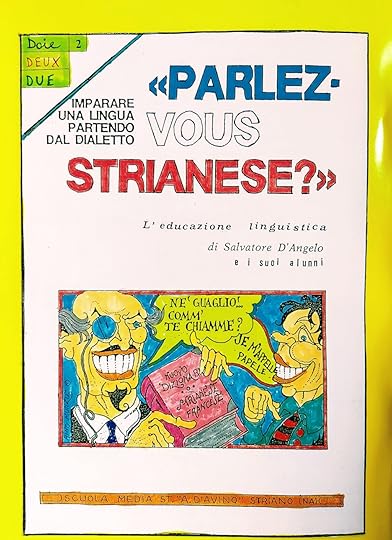

Che dire? Una esperienza davvero unica quella vissuta dal collega e amico Salvatore. Vista alla luce della moderna comunicazione digitale, fa riflettere sui grandi cambiamenti che si sono avuti in questi ultimi decenni.
Non riesco ad immaginare nella scuola di oggi un esperimento del genere, alla luce di tutte le trasformazioni che si sono succedute, e ancora ne verranno, nel campo della comunicazione, in generale ed in quella didattica in particolare.
L’esperimento trilingue attaverso l’uso del dialetto sembra provenire da un altro mondo. Con tutto quello che è accaduto in questi anni, possiamo benissimo parlare come di un “prima” e un “dopo”. Come prima di Cristo o come prima di Gutenberg. In mezzo c’è Internet, il Digitale, lo Smartphone e tutto il resto.
Mi ricordo di una esperienza di “educazione linguistica” di tutt’altro tipo che ebbi in Inghilterra oltre mezzo secolo fa. Ero studente infermiere in un ospedale mentale a nord di Londra quando venni chiamato nell’ufficio della direzione del personale per aiutare a capire cosa diceva un connazionale che non riusciva a farsi capire in inglese.
Era un povero cristo calabrese che doveva essere assunto, per raggiungere sua moglie e la famiglia, ma gli impiegati non riuscivano a capire quello che diceva. Si esprimeva ovviamente in dialetto, che sembrò anche a me difficile da capire. Faticai non poco a comprendere quello che diceva e a risolvere i suoi problemi.
Le interferenze linguistiche erano davvero forti. La sua “lingua”, era il suo “linguaggio”, ed era come un muro invalicabile. Il dialetto era il suo mondo. Non poteva essere il suo “transfer” verso l’inglese, by-passando l’italiano. Una “mission” davvero impossibile. L’insostenibile leggerezza della lingua …[image error]
January 20, 2023
Passato, Presente e Futuro …
 Victor Bregeda
Victor Bregeda
Il dipinto di Victor Bregeda “Passato, presente e futuro” presenta il concetto che ciò che vediamo e percepiamo dipende dal nostro punto di vista, e anche dalla nostra preparazione mentale e dal nostro livello di comprensione.
Qui Victor mostra Cristo come sempre presente, nel passato, ora e per sempre. Tuttavia, l’artista che dipinge sulla battigia, dal suo punto di vista non vede il volto di Cristo che noi vediamo. L’artista vede e dipinge solo l’albero, il cielo e la terra.
La barca simboleggia ciò che ci trasporta dal fisico allo spirituale. Potrebbe trattarsi di insegnamenti che leggiamo in un libro, un’esperienza che abbiamo che aumenta la nostra comprensione, qualcosa che ci dice un amico o qualsiasi altro mezzo per portarci dal fisico allo spirituale. Le bolle che si alzano simboleggiano il modo in cui la conoscenza spirituale percola attraverso la nostra vita quotidiana, come bolle di chiarezza che si alzano attraverso l’acqua.
L’uomo che ha ricevuto la conoscenza ora torna indietro attraverso la stessa area che ha visto in passato con così poca comprensione. Tornando dopo aver raggiunto la coscienza spirituale, cammina sull’acqua poiché è andato oltre le leggi della realtà fisica. Intravede se stesso passato, il fantasma del suo passato, quando era in grado di vedere solo una parte di ciò che era davanti a lui.
Come spettatore, contribuiamo con la prospettiva del futuro al dipinto in quanto solo noi siamo in grado di percepire la presenza di Cristo nella scena. L’uomo con la barca è certamente progredito oltre la consapevolezza del pittore, eppure ha ancora le spalle a Cristo. L’implicazione è che, mentre progredisce ulteriormente, alla fine raggiungerà la percezione necessaria per vedere tutte le dimensioni della realtà.
########################################################
Victor Bregeda’s painting ‘Past, Present, and Future’ presents the concept that what we see and perceive is dependent upon our vantage point, and also on our mental preparedness, and our level of understanding.
Here Victor shows Christ as being always present, in the past, now, and forever. However, the artist painting at the shoreline, from his point of view does not see the face of Christ that we see. The artist sees and paints only the tree, the sky, and the land.
The boat symbolizes that which transports us from the physical to the spiritual. This could be teachings which we read in a book, an experience we have that increases our understanding, something that a friend says to us, or any other means of bringing us from the physical to the spiritual. The bubbles rising up symbolize how spiritual knowledge percolates through our everyday life, like bubbles of clarity rising through water.
The man who has received knowledge now walks back through the same area that he saw in the past with so little understanding. Returning after he has attained spiritual consciousness, he walks on water as he has gone beyond the laws of the physical reality. He glimpses his past self, the ghost of his past, when he was able to see only part of what was before him.
As the viewer, we contibute the perspective of the future to the painting in that we alone are able to perceive the presence of Christ in the scene. The man with the boat has certainly progressed beyond the awareness of the painter, yet he still has his back to Christ. The implication is that, as he progresses further, he will eventually attain the perception necessary to see all dimensions of reality.[image error]
January 18, 2023
In the quest to understand the bee brain …
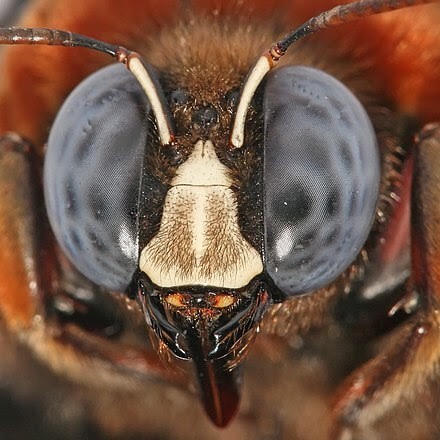 Head-on view of a male carpenter bee, showing antennae, three ocelli, compound eyes, and mouthparts
Head-on view of a male carpenter bee, showing antennae, three ocelli, compound eyes, and mouthpartsIn work he performed in 1896, the American zoologist Frederick Kenyon showed that the brain of the tiny bee was infinitely more complex than anyone had imagined, with thousands upon thousands of connection points, and also showed, for the first time in any organism, that neurons fell into clearly identifiable classes. He died, forgotten, in a lunatic asylum:
“American writer and biologist Frederick Kenyon (1867–1941) was the first to explore the inner workings of the bee brain. His 1896 study, in which he managed to dye and characterize numerous types of nerve cells of the bee brain, was, in the words of the world’s foremost insect neuroanatomist, Nick Strausfeld, ‘a supernova.’ Not only did Kenyon draw the branching patterns of various neuron types in painstaking detail, but he also highlighted, for the first time in any organism, that these fell into clearly identifiable classes, which tended to be found only in certain areas of the brain.
One such type he found in the mushroom bodies is the Kenyon cells, named in his honor. Their cell bodies — the part of the neuron that contains the chromosomes and the DNA — decoding machinery — are in a peripheral area enclosed by the calyx of each mushroom body (the mushroom’s ‘head’), with a few additional ones on the sides of or underneath the calyces. A finely arbored dendritic tree (the branched structure that is a nerve cell’s signal ‘receiver’) extends into the mushroom body calyx, and a single axon (the neuron’s ‘information-sending output cable’) extends from each cell into the mushroom body pedunculus (the mushroom’s ‘stalk’).
Extrapolating from just a few of these characteristically shaped neurons that he could see, Kenyon suggested (correctly) that there must be tens of thousands of such similarly shaped cells, with parallel outputs into each mushroom body pedunculus. (In fact, there are about 170,000 Kenyon cells in each mushroom body.) He found neurons that connect the antennal lobes (the primary relays processing olfactory sensory input) with the mushroom body input region (the calyces, where the Kenyon cells have the fine dendritic trees) — and even suggested, again correctly, that the mushroom bodies were centers of multisensory integration.
Kenyon’s 1896 brain wiring diagram [is a marvel]. It contains several classes of recognizable neuron types, with some suggestions for how they might be connected. Many neurons have extensions as widely branched as fullgrown trees — only, of course, much smaller. Consider that the drawing only shows around 20 of a honey bee brain’s ~850,000 neurons. We now know that each neuron, through its many fine branches, can make up to 10,000 connection points (synapses) with other neurons. There may be a billion synapses in a honey bee’s brain — and, since the efficiency of synapses can be modified by experience, near-infinite possibility to alter the information flow through the brain by learning and memory. It is a mystery to me how, after the publication of such work as Kenyon’s, anyone could have suggested that the insect brain is simple, or that the study of brain size could in any way be informative about the complexities of information processing inside a brain.
Kenyon apparently suffered some of the anxieties all too familiar to many early-career researchers today. Despite his scientific accomplishments, he had trouble finding permanent employment, and moved between institutions several times, facing continuous financial hardship. Eventually, he appears to have snapped, and in 1899 Kenyon was arrested for ‘erratic and threatening behavior’ toward colleagues, who subsequently accused him of insanity. Later that year, he was permanently confined to a lunatic asylum, apparently without any opportunity ever to rehabilitate himself, and he died there more than four decades later — as Nick Strausfeld writes, ‘unloved, forgotten, and alone.’
It was not to be the last tragedy in the quest to understand the bee brain.”
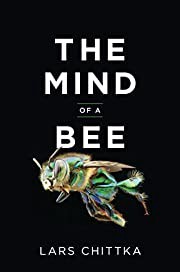 The Book
The Book
[image error]
Delanceyplace.com is a brief daily email with an excerpt or quote we view as interesting or noteworthy, offered with commentary to provide context. There is no theme, except that most excerpts will come from a non-fiction work, primarily historical in focus, and will occasionally be controversial. Finally, we hope that the selections will resonate beyond the subject of the book from which they were excerpted. Sign up to receive Delanceyplace.com every weekday morning.
January 16, 2023
Il Festival della Vita
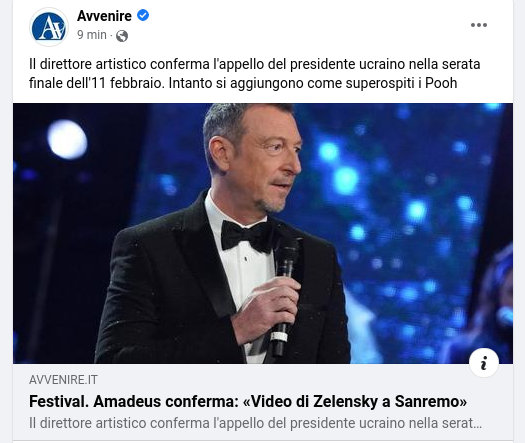 Avvenire
Avvenire
Ecco, le parole sono quelle giuste. Pure con la maiuscola. Il Festival della Vita. Qui da noi in Italia. Con le parole, ci sono tutti. Una città con i suoi fiori, il suo santo e, soprattutto, le sue canzoni. Un rito che, non a caso, “ritorna” implacabile ogni anno, nel bel mezzo di un inverno in ritardo, ma sempre destinato prima o poi ad arrivare. Quando arriva, sia l’uno che l’altro, si fanno sentire ben oltre i confini nazionali, in un inverno dell’anima. Sul palcoscenico con le note, oltre i soliti, allegri canti, risuoneranno anche le dolenti note di tanti che, un bel altro tipo di destino, ha costretti a non poter più cantare. Ci sarà anche il solito cronista scrittore, con il suo ultimo annuale libro e la sua ultima, implacabile intervista, a quell’immancabile presidente che canterà ancora una volta il suo canto di libertà per il suo popolo sempre in guerra. Su quel palcoscenico risuoneranno canti, canzoni e canzonette in tutte le lingue, l’inno del Festival di una Vita (con la maiuscola!) folle, per simboleggiare l’orribile trionfo della Morte di migliaia di innocenti.[image error]
January 12, 2023
Il libro del principe Harry in tre minuti …
 Se non hai tempo o voglia di sfogliare tutte le 520 pagine del libro (edizione italiana) ecco un pratico riepilogo su tutto ciò che devi sapere. In lingua inglese, così migliori la conoscenza della lingua. Se vuoi, puoi leggerlo anche sul giornale “The Telegraph” in originale al link alla fine del post.
Se non hai tempo o voglia di sfogliare tutte le 520 pagine del libro (edizione italiana) ecco un pratico riepilogo su tutto ciò che devi sapere. In lingua inglese, così migliori la conoscenza della lingua. Se vuoi, puoi leggerlo anche sul giornale “The Telegraph” in originale al link alla fine del post.
Spare in three minutes: Your potted guide to Prince Harry’s book.
Don’t have time to plough through all 407 pages? Use our handy summary for all you need to know.
By Laura Powell 12 January 2023 • 11:03am
Prologue
Harry waits for Willy and Pa in Frogmore gardens — admires the Gothic architecture and thinks of his late Grandpa who once made fun of his beard. When Willy and Pa arrive, the atmosphere is tepid. Later it gets heated. Pa says, ‘Please, boys. Don’t make my final years a misery.’
Part One
Chapter 1
Reminisces about a summer in St Tropez with Mummy. Afterwards, Dodi gives Mummy a diamond bracelet. Harry thinks he’s a ‘nice enough bloke’.
Chapter 2
Harry adores Balmoral, even though the tap water runs brown, baths are Arctic cold or kettle hot. Crystal goblets are laid out for dinner with mathematical precision using measuring tapes. He and Willy shared a bedroom — Willy had the bigger half with a better window view.
Chapters 3–6
Pa breaks news of Diana’s car crash to Harry. He considers whether Mummy is actually dead — could she be in hiding? Before the funeral, Uncle Charles (Spencer) is aghast that Willy and Harry are being made to walk behind the coffin and ‘raises hell — it’s barbaric’.
Chapter 7–8
At Ludgrove School he is smitten with two matrons. Matrons assist the youngest boys with nightly wash. Harry graduates from matronly bathing assistance aged 13. ‘But I still depended on their nightly tuck-ins’

Chapter 14
Pooh-poohs rumours that James Hewitt fathered him.
Chapter 15
Formally meets ‘The Other Woman’. Camilla is calm (or bored); the experience is like ‘getting an injection’. Willy and Harry ask Pa not to marry her.
Chapter 18
His friends cut his hair — it never recovers.
Chapter 20
Laments not being an avid reader or a Shakespeare aficionado, like his father. Tries to read Hamlet but it’s too close to the bone.
Chapter 23
Close encounter with a leopard in Africa — suspects it is a messenger from Mummy to say ‘all is well’.
Chapter 24
Smokes what he thinks is strong marijuana — turns out it’s a joint of fresh basil. Later pinches two six-packs of Smirnoff Ice and drinks them with a friend until they pass out.
Chapter 29
Balmoral: Prince Philip cooks Cumberland sausages, the Queen whips up her specialty, salad dressing. Gan-Gan (Queen Mother) asks for a gin martini.
Chapter 32
Smokes spliffs at Eton. Has a Fleabag moment with a fox.
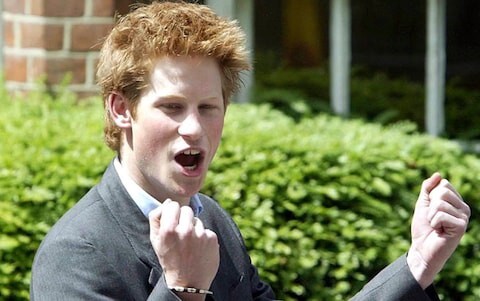
Chapter 33
Loses virginity to the older horsewoman.
Chapter 35
Princess Margaret gives him a biro for Christmas. She scowls a lot.
Chapter 37
Admires Grandma ‘rocking out’ to Brian May at the Golden Jubilee, then notices that she is wearing yellow ear plugs.
Chapter 38
Discusses with Pa what to do after finishing school: Safari guide? Ski instructor? Work in a fondue hut by the slopes? Settles on Army and gap year.
Chapter 43–44
Goes clubbing, meets a Page Three girl. Smokes an ‘entire shopping bag’ of weed.
Chapter 45–47
Meets Chelsy. Go to a snake wrangling show, then have their first kiss.
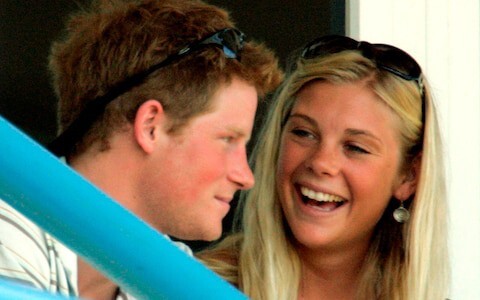
Chapter 48
Charles and Camilla’s wedding is delayed. ‘I couldn’t help but think that some force in the universe (Mummy?) was blocking rather than blessing their union.’
Chapter 50
Meets Willy’s new girlfriend — ‘carefree, sweet, kind’ Kate. The pair encourage him to wear Nazi Uniform to a fancy dress party.
Chapter 52
Given secret police files from Di’s crash. Still believes she is in hiding.
Chapter 58
Willy attends Sandhurst and salutes Harry. ‘For one brief moment, Spare outranked Heir.’
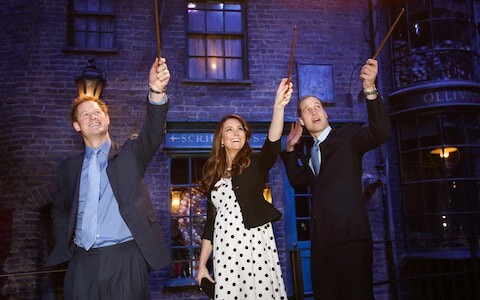
Part 2
Chapter 2
Harry is in a ‘bad, bad place.’ Lots of clubbing and travels home in the boot to avoid paps. ‘It felt like being in a coffin.’
Chapter 8
Asks his driver to drive through the Paris tunnel where Mummy died. Afterwards gets drunk and picks fights.
Chapter 9
Writes his will. Goes to Afghanistan. Considers who would walk behind his coffin if he died.
Chapter 21
Pa and Willy collect him upon his return to England — there’s a ‘hushed’ atmosphere in the car, stiff pleasantries.
Chapter 22–23
Feels distant and out of place. Goes to Botswana to see Chelsy. Worries what the Queen will think of her — all high boots, short skirts, drinking tequila. ‘The last thing I wanted was for Chels to change.’ They break up.
Chapter 24
Meets Caroline Flack — ‘She was funny. And sweet. And cool…Didn’t have a big ego.’ But relationship ‘tainted, irredeemably’ by press attention and they part ways.
Chapter 28
Calls a cadet ‘our little Paki friend’ — didn’t realise it was a racist slur until fallout.
Chapter 31
Moves in with Willy in Shropshire — Pa’s chef sends them vacuum-packed bags of food — creamy chicken and beef curry. Gets angry when Willy tells reporters he’s a slob and snores.
Chapter 40
Finds out that Wills is getting married from Buckingham Palace announcement. ‘News to me… He’d never mentioned it.’
Chapter 42
Goes to North Pole, gets a frostbitten penis. Rushes home for Willy’s wedding. He’s the fake best man — Willy didn’t ‘think it would be safe to hand me a live mic’ for best man speech. Willy does a walkabout while tipsy on rum. Next morning, still reeks of it
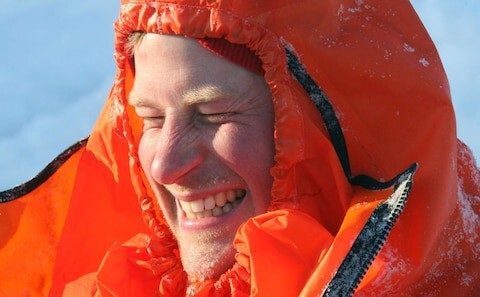
Chapter 49
Goes to Vegas, considers getting a tattoo, ends up playing strip pool. Some ‘dodgy girls’ take photos and share them.
Chapter 50
Offers an ‘abashed explanation’ to current girlfriend Cressida of what happened in Vegas.
Chapter 57
Considers the ramifications of his Afghanistan kill count: 25. ‘It wasn’t a number that gave me any satisfaction… but neither was I ashamed.’ He ‘otherized’ them as ‘bads’.
Chapter 60
Comes up with idea for Invictus Games — Willy is ‘sorely irritated’ that ‘Harold’ hadn’t run it past him.
Chapter 61–62
Harry has ‘terrifying’ panic attacks. Becomes obsessed with Friends — thinks he’s Chandler. Recalls happy days with Diana, having burping contests in front of the TV.
Chapter 65
Struggles with panic attacks and anxiety. Tries homoeopathic remedies, like magnesium, but they give him loose bowels. Goes to the South Pole. Gets a bespoke penis cushion, lined with fleece, to prevent further frostbite.
Chapter 69
Christmas at ‘Hotel Granny’ (Sandringham). Harry gets a small room in a narrow corridor and feels ‘a bit unappreciated. A bit unloved’.
Chapter 71
Cressida gets him to open up about Diana — he cries about his mother for the first time since her burial. Later breaks up with Cress. She cries. ‘I realised we weren’t a match.’

Chapter 78
Willy tells Harry that ‘both he and Kate felt trapped and unfairly persecuted by the press. And by Pa and Camilla.’ Was expected to ‘trot Kate out like a prized racehorse.’
Chapter 80
Harry wears various disguises to the supermarket to buy his salmon fillets. Does his own laundry and dries it on radiators. Folds his underwear. And has a clothing allowance from Pa — goes to TK Maxx on six-monthly shopping sprees.
Chapter 83–85
A therapist tells him he has post-traumatic stress. He’s tried psychedelics — mushrooms and ayahuasca. Considers going to Africa but Willy is annoyed. ‘Africa was his thing, he said.’ Harry goes to Africa anyway. Has a profound moment with a female lion. ‘I felt I knew her.’
Chapter 86–87
Goes to America, stays in Courtney Cox’s house when she is away, drinks tequila. Goes to a party sees the Batman actor. Gobbles some ‘black diamond mushroom chocolates’ then hallucinates that the toilet is a head. Goes to another party. Talks to the moon.
Part Three
Chapter 1
Scrolling Instagram and sees a video of the most ‘beautiful’ woman — Meghan. Asks mutual friend Violet to introduce them.
Chapter 3–7
Late for first date at Soho House. They hit it off but Meghan leaves abruptly. ‘Compared to her, Cinderella was the queen of long goodbyes.’ Later that night, Meghan FaceTimes him.
Have second date 24 hours later, back at Soho House. At the end, Meg says: ‘What’re we gonna dooo?’ Harry says: ‘We have to give this a proper go.’
Chapter 6
Third date in Botswana. Meg packs her yoga mat. She cries when they say goodbye.
Chapter 8–9
Harry goes on a lads trip but messages Meg constantly. Phone breaks so he writes her a letter: ‘Hey beautiful, Ok you got me — can’t stop thinking about you, missing you LOTS. Wish u were here.’ Harry realises she’s The One
Chapter 12
Megs visits Nott Cott and says it’s like a frat house, what with Union Jack flags, Xbox. Eugenie and James come for dinner but Megs has food poisoning — bad calamari. Harry holds her hair while she vomits.

Chapter 14
Harry discovers that Willy and Kate watch Suits religiously.
Chapter 15
Megs bumps into the Queen at Fergie’s house. Prince Andrew is there, holding the Queen’s handbag. Meg asks Haz if Andrew is the Queen’s assistant.
Chapter 16
Will meets Meghan — she hugs him which ‘freaked him out — Willy didn’t hug many strangers.’
Chapter 17
Meghan and Harry have tea with Charles and Camilla. When Meghan and Pa fall into chat, Camilla ‘seemed keener on eavesdropping than talking to her stepson.’
Chapter 18
Harry watches Meghan’s love scenes from Suits.
Chapter 23
Meg teaches him to cook a roast chicken, then they argue. Megs suggests he tries therapy again.
Chapter 25–26
Harry goes to therapy. He vents about Pa, Willy and Camilla and at the end of the session, hugs the therapist.
Chapter 33
Harry wants to marry Meghan. Willy says it’s ‘too fast, too soon’ to propose. Pa says he can’t financially support Meghan if they marry. Asks the Queen and she says, ‘Well I suppose I have to say yes.’
Chapter 35
Harry proposes in the garden.

Chapter 36
Decides that Thomas Markle is a ‘complicated man’.
Chapter 38
Kate is taken aback that Meghan asks to borrow her lip gloss.
Chapter 41
Wills gets cross when he learns Harry can keep his beard on his wedding day. Orders him to shave it off ‘as the heir speaking to the spare.’
Chapter 42
Stag party in Hampshire at a friend’s house — giant boxing gloves, mechanical bull, Lord of the Rings bows and arrows. Willy threatens to hold him down and shave off his beard.
Chapter 43
Tiaragate — Harry says Angela Kelly is the ‘troublemaker’. ‘She was being obstructive.’
Chapter 46
Meghan and Kate exchange terse text messages over ill-fitting bridesmaids’ dresses. Meghan ends up sobbing on the floor. Kate brings her flowers.
Chapter 50
To Willy and Kate’s for tea. They air many disagreements — Kate thought Meg wanted her fashion contacts; Kate and Willy upset that they hadn’t given Easter presents; Harry and Meg accused them of changing seats at their wedding; Kate says she deserves apology for ‘hormone-gate’. Will points at Meg ‘It’s rude, Meghan.’
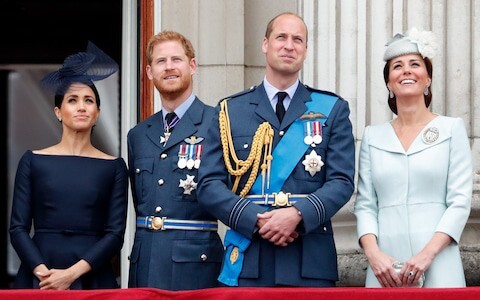
Chapter 51
Rivalry among staff: Team Cambridge versus Team Sussex. Meg buys pizza and biscuits and hosts tea parties for staff, also gets lamps and heaters for the office which she pay for on her personal credit card.
Chapter 52
Meg is told by an ayurvedic doctor to gain 5lbs to get pregnant.
Chapter 53
Meghan and Harry sing to a seal at Castle of Mey in Scotland. The seals sing back.
Chapter 54
Meg is pregnant.
Chapter 60
Harry finds Meg sitting on the stairs sobbing uncontrollably. She doesn’t want to be alive.
Chapter 62–63
Harry has a big fight with Willy — dog-bowl gate. The households split
Chapter 65
Meg gives birth — Harry eats Nando’s chicken and gets high on the ‘laughing gas’.
Chapter 75
The ill-fated Sandringham Summit. Harry says it was a foregone conclusion before he arrived. He ran into Lady Susan Hussey who was sympathetic.
Chapter 77
Harry’s security is withdrawn. Pa won’t take his calls. Bemoans that Prince Andrew gets to keep security even though he was ‘embroiled in a shameful scandal’.
Chapter 79
Tyler Perry offers up his LA house. His mother was a big Diana fan.

Chapter 81
Harry rolls joints when his family are in bed and ruminates about the ‘absurdity of a man in his mid-30s being cut off financially by his father. But he wasn’t merely my father, he was my boss, my banker, keeper of the purse strings…’
Chapter 83
Meghan gives Harry a Christmas tree ornament that looks like the Queen. It smashes.
Chapter 86
Back to the Frogmore Gardens walk with Willy and Pa. He calls them both ‘delusional’. When he says goodbye, Willy grabs him, says he loves him, wants him to be happy. ‘I swear on Mummy’s life.’ Harry doesn’t believe him.
Chapter 87
Lili is born. Meghan says she has never loved Harry more.
Epilogue
The Queen is in a critical condition. Pa says Meghan can’t come to Balmoral with Harry. ‘His reason was nonsensical, and disrespectful and I wasn’t having it.’ Harry finds out the Queen has died from the BBC while en route. Princess Anne greets him — Willy, Pa and Camilla are nowhere to be seen.
Afterwards, back in LA, Harry has another profound animal moment — a hummingbird is trapped in his house. Harry helps it. ‘You’re free. Fly away.’
By Laura Powell 12 January 2023 • 11:03am
THE TELEGRAPH[image error]
January 8, 2023
Chi pagherà l’Intelligenza Artificiale generativa?

All’inizio, diciamo la verità, ci siamo divertiti un mondo a giocare con l’intelligenza artificiale generativa. C’è chi ha creato per vanità centinaia di avatar di sé stesso, chi si è improvvisato illustratore e chi ha fiutato il business e si è messo a studiare per diventare un nuovo genere di artista generativo. Qualcuno poi ha passato le vacanze di Natale a conversare con ChatGPT di Open Ai, altri si sono messi sul lettino come davanti a uno psicanalista e molti si sono limitati a interrogarlo come se fosse un bambino. Ma i più lo hanno usato per scoprire cose nuove da imparare. E in certi casi ha funzionato.
Poi però è subentrata l’inquietudine. Perché dopo anni di rivoluzioni attese come il metaverso, la blockchain o le auto a guida autonoma, dopo telefonini e tablet ogni anno più belli ma quasi sempre tutti uguali, serviva qualcosa di nuovo che funzionasse. L’intelligenza artificiale nel 2022 è stata una sorpresa. A partire dai generatori di immagini come appunto Dall-E 2, Midjourney e Stable Diffusion. Tanto che a qualche artista tradizionale sono anche girate le scatole. Non per la competizione teorica con la “macchina”. Ma perché avere accanto qualcuno che sa copiare benissimo lo stile di altri e produce a getto continuo non è il massimo della vita per un produttore di contenuti.
Sui social sono comparsi migliaia di messaggi con pezzi di conversazione dove si leggono strafalcioni, stereotipi di genere ed errori di matematica. E tutto questo solo per affermare che l’AI non è onnisciente. Che non sa tutto, cosa che peraltro già si sapeva. C’è perfino chi ha immaginato un nuovo ordine mondiale del Web non più dominato dai motori di ricerca, ma da questi chatbot che dialogano con voi e forniscono risposte più articolate.
Quello che però nessuno ha fatto è stato di provare a capire da analista finanziario i “fondamentali” di questo fenomeno. Come funzionano, quanto costano? O per essere più diretti: come si fanno i soldi con questi strumenti? Nessuno ancora lo ha capito. Secondo alcuni osservatori questi tool sostituiranno a breve i motori di ricerca. La nuova versione di Bing di Microsoft, che potrebbe arrivare già a marzo 2023, farà uso della tecnologia di IA alla base di ChatGPT per determinate chiavi di ricerca.
Ma per essere utilizzabili, questi algoritmi dovrebbero poter garantire un altissimo livello di accuratezza nelle risposte che restituiscono. E così oggi non è. E poi c’è un tema di costi energetici. Come ha ammesso Sam Altman, Ceo di OpenAI quando hanno raggiunto un milione di utenti le spese per la manutenzione e gestione del sistema sono altissimi. Nel caso di ChatGPT sappiamo che è ospitato sul cloud Azure di Microsoft. Sul web hanno calcolato in base ai costi del cloud di Microsoft che ogni parola generata su ChatGPT costa 0,0003 dollari. Vuole dire bruciare almeno 3 milioni al mese per i costi di gestione. Prima o poi qualcuno dovrà cominciare a trovare un modello di business e un prezzo per questi servizi. Fino ad allora Google può stare tranquilla.
Luca Tremolada — Nova 24 — Il Sole 24 Ore 8 gennaio 2023[image error]
January 7, 2023
Un altro me nel “multiverso”?
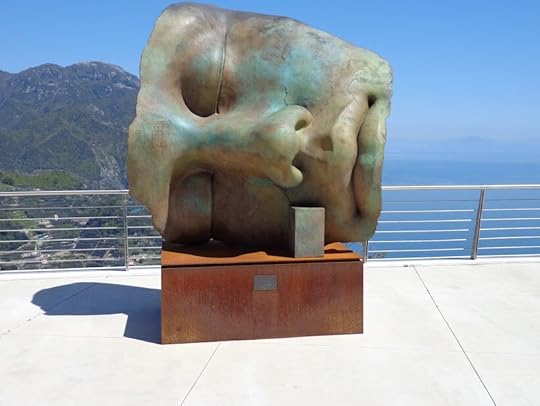
“Nessuno è stato mai me. Può darsi che io sia il primo. Nobody has been me before. Maybe I’m the first one.”
Questo è il mio biglietto da visita su MEDIUM. Al momento non è noto se esistano altre versioni di noi stessi in universi paralleli. Il concetto di universi paralleli, noto anche come teoria del “multiverso”, è una possibile spiegazione per alcuni fenomeni inspiegabili in fisica e cosmologia.
Tuttavia, è importante notare che l’esistenza di universi paralleli è ancora oggetto di speculazione scientifica e non è stata dimostrata.
Secondo alcune interpretazioni della fisica moderna, la teoria del multiverso suggerisce che potrebbero esistere molti altri universi oltre al nostro, ciascuno con il proprio insieme di leggi e proprietà fisiche.
Alcuni scienziati ritengono che questi universi paralleli possano essersi formati a seguito del Big Bang, o che possano essere sempre esistiti accanto al nostro universo.
Non ci sono prove dirette dell’esistenza di universi paralleli e il concetto rimane oggetto di dibattito e speculazione nella comunità scientifica.
Alcuni scienziati ritengono che sia possibile che ci possano essere altre versioni di noi stessi in altri universi, mentre altri sono più scettici e credono che il concetto di universi paralleli sia puramente teorico e potrebbe non essere mai provato.
— — —
It is currently unknown whether there are other versions of ourselves in parallel universes. The concept of parallel universes, also known as the “multiverse” theory, is a possible explanation for some unexplained phenomena in physics and cosmology. However, it is important to note that the existence of parallel universes is still a matter of scientific speculation and has not been proven.
According to some interpretations of modern physics, the multiverse theory suggests that there may be many other universes besides our own, each with its own set of physical laws and properties. Some scientists believe that these parallel universes may have formed as a result of the Big Bang, or may have always existed alongside our own universe.
There is no direct evidence for the existence of parallel universes, and the concept remains a subject of debate and speculation in the scientific community. Some scientists believe that it is possible that there could be other versions of ourselves in other universes, while others are more skeptical and believe that the concept of parallel universes is purely theoretical and may never be proven.[image error]
‘A furmica è ‘na criatura …
 Inedito di Gino De Filippo
Inedito di Gino De FilippoRicordo la genesi di questo sonetto. Gino ed io camminavamo sulla pista a Episcopio, nella Valle dei Sarrasti, alla maniera di Kant, nella immagine che vedete qui sotto, quando ci accorgemmo che una lunga, interminabile fila di minuscole formiche costeggiavano il nostro percorso. Sembrava quasi che volessero affiancarsi ai molti camminatori che hanno l’abitudine di fare footing percorrendo questa lunga pista intorno ad una delle vasche costruite ai piedi del monte Saro dopo i tragici eventi del 5 maggio 1998.
Seguimmo quel lungo, affollato corteo per un centinaio di metri, fino a quando quelle milioni di “criature” deviarono scendendo verso il fondo dell’invaso, disperdendosi negli infiniti spazi del terreno. Gino ne osservò una che, tutta sola, sembrava, secondo lui, avere smarrito il senso della direzione. Il giorno dopo mi fece leggere questo sonetto e mi disse che non aveva potuto dormire pensando a queste misteriose e magiche “criature”…
 La passeggiata di Kant
La passeggiata di Kant
Le formiche hanno molto successo come specie per varie ragioni. Uno dei motivi è la loro struttura sociale altamente organizzata, che consente loro di lavorare efficacemente insieme in grandi gruppi. Le colonie di formiche sono in grado di dividere il lavoro, con diverse formiche specializzate in compiti diversi come cercare cibo, prendersi cura dei piccoli e difendere la colonia. Questa divisione del lavoro consente alle colonie di formiche di essere molto efficienti e produttive.
Un altro motivo del successo delle formiche è la loro capacità di adattarsi a una vasta gamma di ambienti. Le formiche si trovano in tutti i continenti, tranne l’Antartide, e possono prosperare in molti tipi di habitat, dal deserto caldo e secco all’umida foresta pluviale tropicale. Questa adattabilità consente ad esse di sfruttare un’ampia gamma di risorse e di stabilire colonie in aree in cui altre specie potrebbero non essere in grado di sopravvivere.
Le formiche poi hanno una serie di comportamenti e adattamenti che le aiutano a sopravvivere e prosperare nel loro ambiente. Ad esempio, alcune specie hanno un senso dell’olfatto molto sviluppato, lo usano per trovare il cibo e per comunicare con gli altri membri della loro colonia. Altre specie hanno mascelle e pungiglioni potenti, che usano per difendere le loro colonie dai predatori. Questi e altri adattamenti hanno permesso alle formiche di diventare uno dei gruppi di insetti più abbondanti e di maggior successo del pianeta.
— — —
Con le loro oltre diecimila specie, le formiche hanno avuto, in termini di capacità di sopravvivenza, dominazione del territorio e genialità di soluzioni organizzative, più successo del genere umano. Perché? Come? Alla vita e alle avventure di quelli che taluno potrebbe definire gli abitanti più riusciti del pianeta Terra hanno dedicato decenni di osservazioni e ricerche gli autori di questo libro: E. O. Wilson, il creatore della sociobiologia, e il mirmecologo B. Hölldobler.
Così essi hanno decifrato per noi, quasi partecipandone, il mondo feroce e generoso delle formiche. Feroce per la durezza degli esiti, anche mortali, imposti all’individuo da strutture di comportamento quali l’inflessibile gerarchia e l’organizzazione sociale in caste; generoso per il benessere che da queste stesse strutture sociali deriva alla comunità quindi agli individui. Sia la ferocia che la generosità hanno la medesima radice: la cooperazione, uno dei risultati più controintuitivi e sorprendenti dell’evoluzione naturale.
Se Wilson ha dimostrato di avere quella capacità di diventare insetto fra gli insetti — un po’ alla maniera di Fabre — che è uno dei contrassegni più sicuri del grande naturalista, al tempo stesso l’osservazione tenace lo ha spinto verso complesse elaborazioni teoriche: tutta la concezione della sociobiologia deve molto a tali ricerche. E altri risultati cruciali vengono raggiunti nel corso di queste indagini, come ad esempio la scoperta del ruolo dei feromoni nella segnalazione e nella comunicazione all’interno della colonia.
Hölldobler e Wilson, inoltre, affrontano da più parti l’inquietante nesso tra superorganismo (la colonia) e altruismo (dell’individuo), apportando fra le righe contributi epistemologici significativi. Come i lavori di Eugène Marais sulle termiti e di Karl von Frisch sulle api, Formiche rimarrà un classico dell’etologia, poiché suscita in chi lo legge una tensione pari a quella di un rapinoso romanzo — o anche di un resoconto di esplorazione.
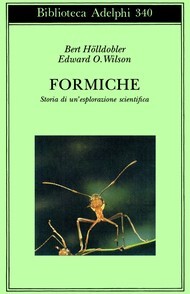 Il Libro
[image error]
Il Libro
[image error]
January 6, 2023
Conversando con il “Mondo Nuovo” …
 Il Mondo Nuovo
Il Mondo Nuovo
“Originale o plagiario, l’uomo è il romanziere di se stesso”, scriveva Ortega y Gasset in uno dei suoi libri. Ogni uomo è un libro, ogni libro è un uomo. Siamo tutti nella Biblioteca dell’Umanità con le nostre storie. La libreria/biblioteca di Babel è sempre aperta. Qohelet è il bibliotecario…
Sembra che tu stia descrivendo l’idea che ogni persona è unica e ha la propria storia da raccontare, e che queste storie fanno tutte parte della narrativa più ampia dell’umanità. La citazione di Ortega y Gasset suggerisce che ogni persona è il romanziere della propria vita e che le sue esperienze e azioni contribuiscono alla più grande biblioteca dell’esperienza umana. Il riferimento alla libreria di Babele e a Qohelet come bibliotecario suggerisce che questa biblioteca è vasta e onnicomprensiva, e che c’è sempre di più da imparare e scoprire sull’esperienza umana.
Così mi ha risposto l’algoritmo della Intelligenza Artificiale. ChatGPT, noto anche come chat Generative Pretrained Transformer, è uno strumento di elaborazione del linguaggio naturale che utilizza algoritmi di apprendimento automatico per generare risposte simili a quelle umane all’input dell’utente.
ChatGPT è addestrato su una grande quantità di dati di testo, consentendogli di generare risposte pertinenti e coerenti in un determinato contesto. Questa tecnologia ha il potenziale per migliorare notevolmente il modo in cui interagiamo con la tecnologia, dal servizio clienti alla traduzione linguistica.
ChatGPT utilizza algoritmi avanzati di apprendimento automatico per analizzare grandi quantità di dati di testo e generare risposte basate su tale analisi. Quando un utente inserisce un messaggio, ChatGPT elabora l’input e genera una risposta pertinente e coerente nel contesto della conversazione.
ChatGPT ha una vasta gamma di potenziali applicazioni, tra cui il servizio clienti, la traduzione linguistica e persino la scrittura creativa. Nel servizio clienti, ChatGPT può essere utilizzato per gestire domande comuni e fornire risposte rapide e accurate ai clienti. Nella traduzione linguistica, ChatGPT può aiutare a tradurre il testo da una lingua all’altra, consentendo una comunicazione più fluida tra persone che parlano lingue diverse. Nella scrittura creativa, ChatGPT può aiutare a generare idee per storie e altri lavori scritti, consentendo agli scrittori di esplorare nuove idee ed espandere la propria creatività.
Nel complesso, ChatGPT è uno strumento di elaborazione del linguaggio naturale potente e versatile che ha il potenziale per migliorare notevolmente il modo in cui comunichiamo e interagiamo con la tecnologia. È uno sviluppo entusiasmante nel campo dell’intelligenza artificiale e ha il potenziale per rivoluzionare il modo in cui interagiamo con le macchine.
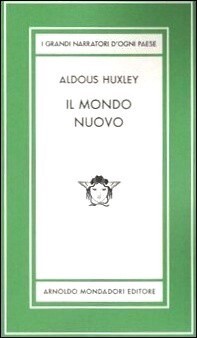 Il Libro
[image error]
Il Libro
[image error]
January 4, 2023
In attesa del suo ultimo libro …
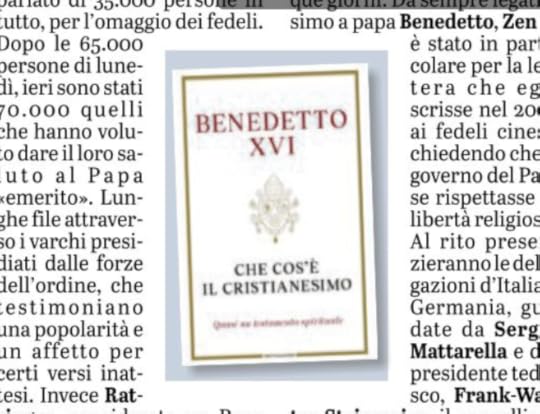 In attesa del suo ultimo libro
In attesa del suo ultimo libroOgni uomo è un libro, ogni libro è un uomo. Ogni uomo ha una faccia, ogni faccia è un uomo. Come tutti gli uomini anche i libri hanno una faccia. Si chiama copertina. Questa è quella di un libro che ne contiene molte, quanti sono i libri scritti da un Uomo che è stato, ed è ancora Papa, anche “emerito”.
Autore di molti libri, quindi tante copertine. Tante facce quante ne può avere il rappresentante del figlio di Dio, fattosi uomo per la salvezza di tutti gli uomini. Un libro dei libri, un itinerario inconsueto che tocca i tanti aspetti della vita di un Uomo e della sua Chiesa, un libro aperto verso il futuro, verso i libri che vennero, che sono venuti e che verranno. Visto che, Lui, l’Autore, Joseph Ratzinger, quasi centenario, è ancora qui tra di noi.
L’opera letteraria, quella di un libro, si sa, è costituita da un testo formato da una più o meno lunga serie di enunciati verbali, ricchi più o meno di significato. Ma qui c’è tutta una serie di sole copertine, facce di libri, le quali nella loro nudità, rappresentano un testo, tanti testi sui quali nulla viene detto e scritto. Tutte insieme formano un contesto il quale , a sua volta, forma un altro testo, una sorta di “paratesto”. Attraverso di esso il testo diventa libro e in quanto tale si propone alla lettura.
In effetti, quando ho proceduto ad acquistare questo libro, non ho fatto altro che avere tra le mani un volume di circa trecento pagine, di cui 267 sono riproduzioni di facce, copertine di libri scritti dall’autore. Le rimanenti pagine sono dedicate alla bibliografia. In queste pagine c’è lo spazio privilegiato di una pragmatica e di una strategia di scrittura rivolta al lettore con un compito ben preciso: descrivere la missione dello scrittore nei confronti di un lettore che non è solo l’uomo che legge ma anche l’uomo che crede.
Le copertine dei libri non sono soltanto facce ornamentali di un oggetto chiamato libro. Esse nascondono, anzi trasmettono, un messaggio significante, un luogo di parola all’interno del quale risuonano temi essenziali presenti nell’opera e nella azione di chi questi testi li ha scritti. Sono molti, scritti in molte lingue, tutti firmati come Joseph Ratzinger e non intesi come scrittura di un atto magisteriale ma “unicamente come espressione della mia ricerca personale”.
L’Autore non scrive mai dall’alto di una cattedra. Vuole soltanto sollecitare una conferma, invitare ad un confronto, eliminare gli ostacoli alla comprensione di un incontro con il mistero di un Dio che si è fatto uomo e cerca l’incontro con gli altri uomini. Gesù di Nazaret non è soltanto un personaggio storico, ma anche una persona che continua a vivere tra di noi con la sua resurrezione. Joseph Ratzinger ce lo descrive nei suoi libri, con tante copertine. Le molte facce dei libri per un unico volto: la rivelazione del mistero.
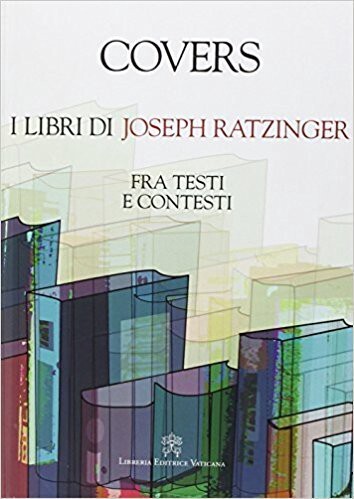 Il Libro
[image error]
Il Libro
[image error]
MEDIUM
- Antonio Gallo's profile
- 52 followers



